Landfill Site Selection Using a Multi-Criteria Decision-Making Method: A Case Study of the Salafcheghan Special Economic Zone, Iran
Abstract
:1. Introduction
Study Area
2. Data and Methods
2.1. Data Collection, Preparation, and Weighting
- Conversion of the projection system of all maps into Universal Transverse Mercator (UTM Zone 39 N)
- Unification of identical land use in the land use map
- Separation of information considering the studied range (clip)
2.1.1. Preparation of Factor Maps
- Rasterizing the format of input maps: the vector maps of polygon, point, and line type were rasterized by the Path Distance function. However, polygon-type maps were rasterized using the direct command for polygons.
- Reclassification: At this stage, rasterized maps were classified using the Reclassify tool while considering the classes determined in Table 3.
- In order to prepare a slope factor map using contour lines, the slope command was used. Further, using Radial Basis Functions (RBF), the factor map of groundwater depth was prepared.
2.1.2. Weighting Parameters Using AHP Analysis
2.2. Data Integration and Decision-Making
3. Results
4. Validation of the Results
5. Discussion and Conclusions
Author Contributions
Conflicts of Interest
References
- Persson, L.; Karlsson-Vinkhuyzen, S.; Lai, A.; Persson, A.; Fick, S. The Globally Harmonized System of Classification and Labelling of Chemicals—Explaining the Legal Implementation Gap. Sustainability 2017, 9, 2176. [Google Scholar] [CrossRef]
- Fathi, T. Environmental Site Selection Criteria for Hazardous Waste Landfills. In Proceedings of the Third National Conference on Waste Management, Tehran, Iran, 21–22 April 2007. [Google Scholar]
- Kianbakhsh, M.; Saeedi, M. Site Selection and Prioritize Industrial Waste Landfill of Shahid Rajaee Qazvin Powerhouse Using Geographic Information System (GIS). In Proceedings of the Twenty-fourth International Conference on Electricity, Tehran, Iran, 16–18 November 2009; Tavanir Company: Tehran, Iran. [Google Scholar]
- Yousefi-Sahzabi, A.; Sasaki, K.; Yousefi, H. Some Thoughts on the Notion of Environmental Information Science. Electron. Green J. 2014, 1, 1–16. [Google Scholar]
- Yousefi, H.; Noorollahi, Y.; Hajinezhad, A.; Alimohammadi, A. GIS-based spatially integrated bioenergy resources assessment in Kurdistan Province-Northwest Iran. Sustain. Energy Technol. Assess. 2017, 23, 11–20. [Google Scholar] [CrossRef]
- Noorollahi, Y.; Yousefi, H.; Mohammadi, M. Multi-criteria decision support system for wind farm site selection using GIS. Sustain. Energy Technol. Assess. 2016, 13, 38–50. [Google Scholar] [CrossRef]
- Yousefi-Sahzabi, A.; Sasaki, K.; Yousefi, H.; Pirasteh, S.; Sugai, Y. GIS aided prediction of CO2 emission dispersion from geothermal electricity production. J. Clean. Prod. 2011, 19, 982–1993. [Google Scholar] [CrossRef]
- Yousefi-Sahzabi, A.; Sasaki, K.; Djamaluddin, I.; Yousefi, H.; Sugai, Y. GIS modeling of CO2 emission sources and storage possibilities. Energy Procedia 2011, 4, 2831–2838. [Google Scholar] [CrossRef]
- Rezai, A.; Dehzad, B.; Omrani, G.H.; Hashempoor, Y.; Fakhim Ahmadi, H. Studies of Site Selection and Optimal Disposal of Solid Waste Management, New City of Hashtgerd. In Proceedings of the Tenth National Conference of Environmental Health, Hamedan, Iran, 30 October–1 November 2007. [Google Scholar]
- Sumathi, V.R.; Natesan, U.; Sarkar, C. GIS-based approach for optimized siting of municipal solid waste landfill. Waste Manag. 2008, 28, 2146–2160. [Google Scholar] [CrossRef] [PubMed]
- Sharifi, M.; Hadidi, M.; Vessali, E.; Mosstafakhani, P.; Taheri, K.; Shahoie, S.; Khodamoradpour, M. Integrating multi-criteria decision analysis for a GIS-based hazardous waste landfill sitting in Kurdistan Province, western Iran. Waste Manag. 2009, 29, 2740–2758. [Google Scholar] [CrossRef] [PubMed]
- Yousefi, H.; Zahedi, S.; Niksokhan, M.H. Modifying the analysis made by water quality index using multi-criteria decision making methods. J. Afr. Earth Sci. 2018, 138, 309–318. [Google Scholar] [CrossRef]
- Gbanie, S.P.; Tengbe, P.B.; Momoh, J.S.; Medo, J.; Kabba, V.T.S. Modelling landfill location using geographic information systems (GIS) and multi-criteria decision analysis (MCDA): Case study Bo, southern Sierra Leone. Appl. Geogr. 2013, 36, 3–12. [Google Scholar] [CrossRef]
- Singh, A.P.; Vidyarthi, A.K. Optimal allocation of landfill disposal site: A fuzzy multi-criteria approach. Iran. J. Environ. Health Sci. Eng. 2008, 5, 25–34. [Google Scholar]
- Abessi, O.; Saeedi, M. Site selection of a hazardous waste landfill using GIS technique and priority processing, a power plant waste in Qazvin province case example. Environ. Sci. 2009, 6, 121–134. [Google Scholar]
- Nas, B.; Cay, T.; Iscan, F.; Berktay, A. Selection of MSW landfill site for Konya, Turkey using GIS and multi-criteria evaluation. Environ. Monit. Assess. 2010, 160, 491–500. [Google Scholar] [CrossRef] [PubMed]
- Pires, A.; Chang, N.-B.; Martinho, G. An AHP-based fuzzy interval TOPSIS assessment for sustainable expansion of the solid waste management system in Setúbal Peninsula, Portugal. Resour. Conserv. Recycl. 2011, 56, 7–21. [Google Scholar] [CrossRef]
- Jafari, H.R.; Rafii, Y.; Ramezani Mehrian, M.; Nasiri, H. Urban landfill site selection using AHP and SAW in GIS environment, case study: Kohkiluye-o-Boyer Ahmad Province, Iran. J. Environ. Stud. 2012, 38, 37–39. [Google Scholar]
- Demesouka, O.E.; Vavatsikos, A.P.; Anagnostopoulos, K.P. Suitability analysis for siting MSW landfills and its multicriteria spatial decision support system: Method, implementation and case study. Waste Manage. 2013, 33, 1190–1206. [Google Scholar] [CrossRef] [PubMed]
- Davami, A.H.; Moharamnejad, N.; Monavari, S.M.; Shariat, M. An urban solid waste landfill site evaluation process incorporating GIS in local scale environment: A case of Ahvaz city, Iran. Int. J. Environ. Res. 2014, 8, 1011–1018. [Google Scholar]
- Beskese, A.; Demir, H.H.; Ozcan, H.K.; Okten, H.E. Landfill site selection using fuzzy ahp and fuzzy TOPSIS: A case study for Istanbul. Environ. Earth Sci. 2015, 73, 3513–3521. [Google Scholar] [CrossRef]
- Khan, D.; Samadder, S.R. Municipal solid waste management using Geographical Information System aided methods: A mini review. Waste Manag. Res. 2014, 32, 1049–1062. [Google Scholar] [CrossRef] [PubMed]
- Chabuk, A.; Al-Ansari, N.; Hussain, H.M.; Knutsson, S.; Pusch, R.; Laue, J. Combining GIS Applications and Method of Multi-Criteria Decision-Making (AHP) for Landfill Siting in Al-Hashimiyah Qadhaa, Babylon, Iraq. Sustainability 2017, 9, 1932. [Google Scholar] [CrossRef]
- Korucu, M.K.; Erdagi, B. A criticism of applications with multi-criteria decision analysis that are used for the site selection for the disposal of municipal solid wastes. Waste Manag. 2012, 32, 2315–2323. [Google Scholar] [CrossRef] [PubMed]
- Salman Mahini, A.; Gholamalifard, M. Siting MSW landfills with a weighted linear combination methodology in a GIS environment. Int. J. Environ. Sci. Technol. 2006, 3, 435–445. [Google Scholar] [CrossRef]
- Moeinaddini, M.; Khorasani, N.; Danehkar, A.; Darvishsefat, A.A.; Zienalyan, M. Siting MSW landfill using weighted linear combination and analytical hierarchy process (AHP) methodology in GIS environment (case study: Karaj). Waste Manag. 2010, 30, 912–920. [Google Scholar] [CrossRef] [PubMed]
- Bottero, M.; Comino, E.; Riggio, V. Application of the analytic hierarchy process and the analytic network process for the assessment of different waste water treatment systems. Environ. Model. Softw. 2011, 26, 1211–1224. [Google Scholar] [CrossRef]
- Pandey, P.C.; Sharma, L.K.; Nathawat, M.S. Geospatial strategy for sustainable management of municipal solid waste for growing urban environment. Environ. Monit. Assess. 2011, 184, 2419–2431. [Google Scholar] [CrossRef] [PubMed]
- Moghaddas, N.H.; Namaghi, H.H. Hazardous waste landfill site selection in Khorasan Razavi Province, Northeastern Iran. Arab. J. Geosci. 2011, 4, 103–113. [Google Scholar] [CrossRef]
- Isalou, A.A.; Zamani, V.; Shahmoradi, B.; Alizadeh, H. Landfill site selection using integrated fuzzy logic and analytic network process (F-ANP). Environ. Earth Sci. 2013, 68, 1745–1755. [Google Scholar] [CrossRef]
- Arkoc, O. Municipal solid waste landfill site selection using geo-graphical information systems: A case study from Çorlu, Turkey. Arab. J. Geosci. 2014, 7, 4975–4985. [Google Scholar] [CrossRef]
- Gorsevski, P.V.; Donevska, K.R.; Mitrovski, C.D.; Frizado, J.P. Integrating multi-criteria evaluation techniques with geographic information systems for landfill site selection: A case study using ordered weighted average. Waste Manag. 2012, 32, 287–296. [Google Scholar] [CrossRef] [PubMed]
- Feo, G.D.; Gisi, S.D. Using MCDA and GIS for hazardous waste landfill siting considering land scarcity for waste disposal. Waste Manag. 2014, 34, 2225–2238. [Google Scholar] [CrossRef] [PubMed]
- Darban Astaneh, A.R.; Tavakoli Nagmeh, M.; Talkhabi, A. Review of Socioeconomics Impacts of Special Economic Zones (Case Study: Salafchegan Special Economic Zone in Qom Province). J. Reg. Plan. 2016, 5, 111–124. [Google Scholar]
- Jones, C.B. Geographical Information Systems and Computer Cartography; Routledge: Abingdon-on-Thames, UK, 2014. [Google Scholar]
- Bonham-Carter, G.F. Geographic Information Systems for Geoscientists: Modelling with GIS; Pergamon Press: New York, NY, USA, 1994; p. 416. [Google Scholar]
- Saaty, T.L. The Analytic Hierarchy Process; McGraw-Hill International: New York, NY, USA, 1980. [Google Scholar]
- Yousefi, H.; Yousefi-Sahzabi, A.; Masih, M.; Ghaleh, S.; Mirzaaghabeik, M. Urban Parks Prioritization Concerning the Age-friendly Criteria in Sari, Northern Iran. Int. J. Occup. Hyg. 2017, 8, 116–123. [Google Scholar]
- Ali, S.; Lee, S.-M.; Jang, C.-M. Determination of the Most Optimal On-Shore Wind Farm Site Location Using a GIS-MCDM Methodology: Evaluating the Case of South Korea. Energies 2017, 10, 2072. [Google Scholar] [CrossRef]
- Lyu, H.-M.; Shen, J.S.; Arulrajah, A. Assessment of Geohazards and Preventative Countermeasures Using AHP Incorporated with GIS in Lanzhou, China. Sustainability 2018, 10, 304. [Google Scholar] [CrossRef]
- Stojković, S.; Đurđić, S.; Anđelković, G. Application of multi-criteria analysis and GIS in ecotourism development (Case study: Serbian Danube region). Glasnik Srpskog Geografskog Društva 2015, 95, 51–66. [Google Scholar] [CrossRef]
- Serbu, R.; Marza, B.; Borza, S. A Spatial Analytic Hierarchy Process for Identification of Water Pollution with GIS Software in an Eco-Economy Environment. Sustainability 2016, 8, 1208. [Google Scholar] [CrossRef]
- Environmental Protection Organization of Iran. Set Rules and Regulations of the Environmental Protection. In Waste Management Law; Environmental Protection Organization of Iran: Tehran, Iran, 2014. [Google Scholar]
- Makhdoom, M. Fundamentals of Land Use Planning; Tehran University Press: Tehran, Iran, 2001. [Google Scholar]
- Golchin, A. Heavy Metal Contamination Sources of Soils and Agriculture Products in Zanjan Province; Research Report; Zanjan Management and Planning Organization: Zanjan, Iran, 2005. [Google Scholar]
- Qom Environmental Protection Organization. Preliminary Landfill Site Suitability Report; Qom Environmental Protection Organization: Qom, Iran, 2004; p. 11. [Google Scholar]
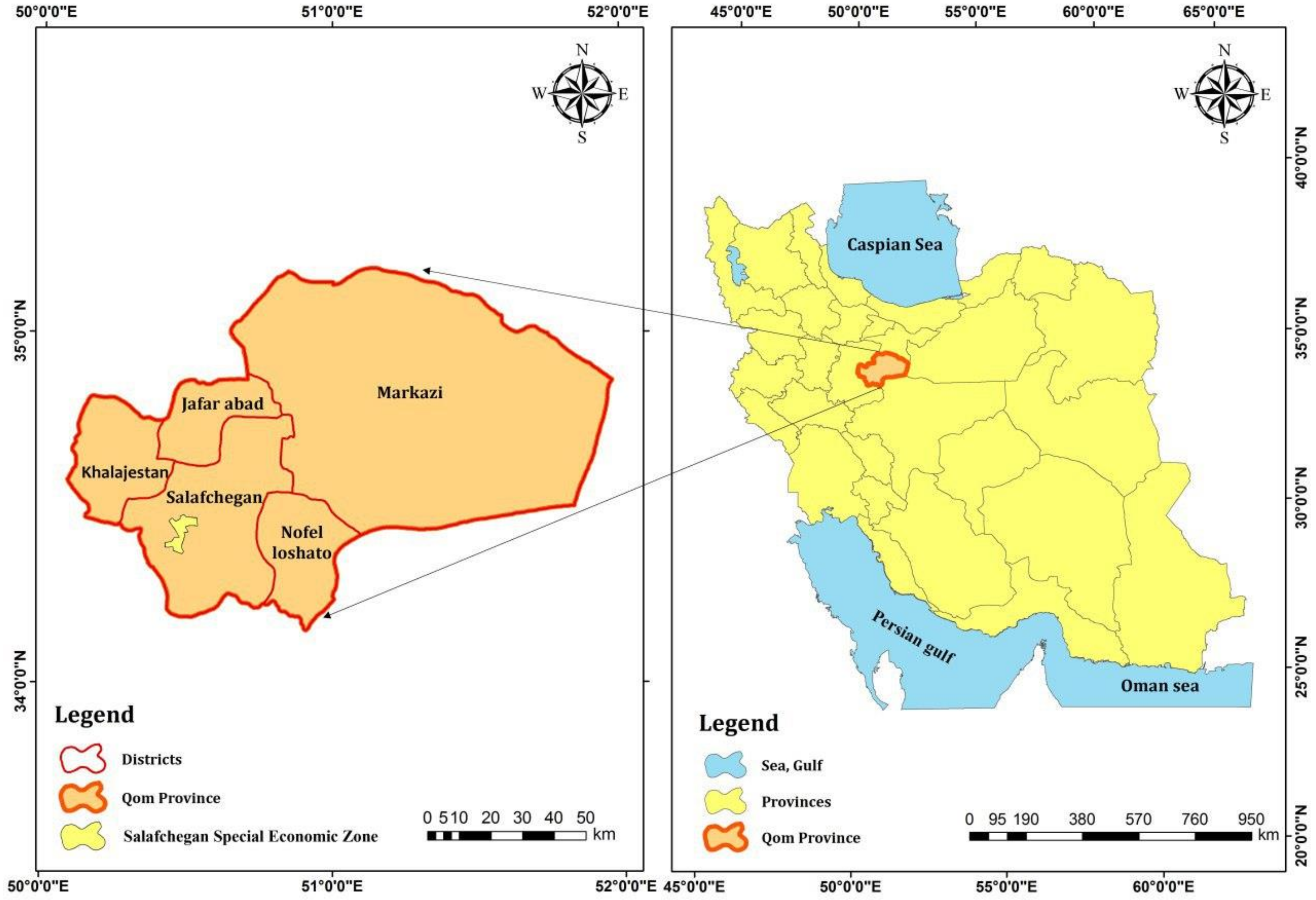
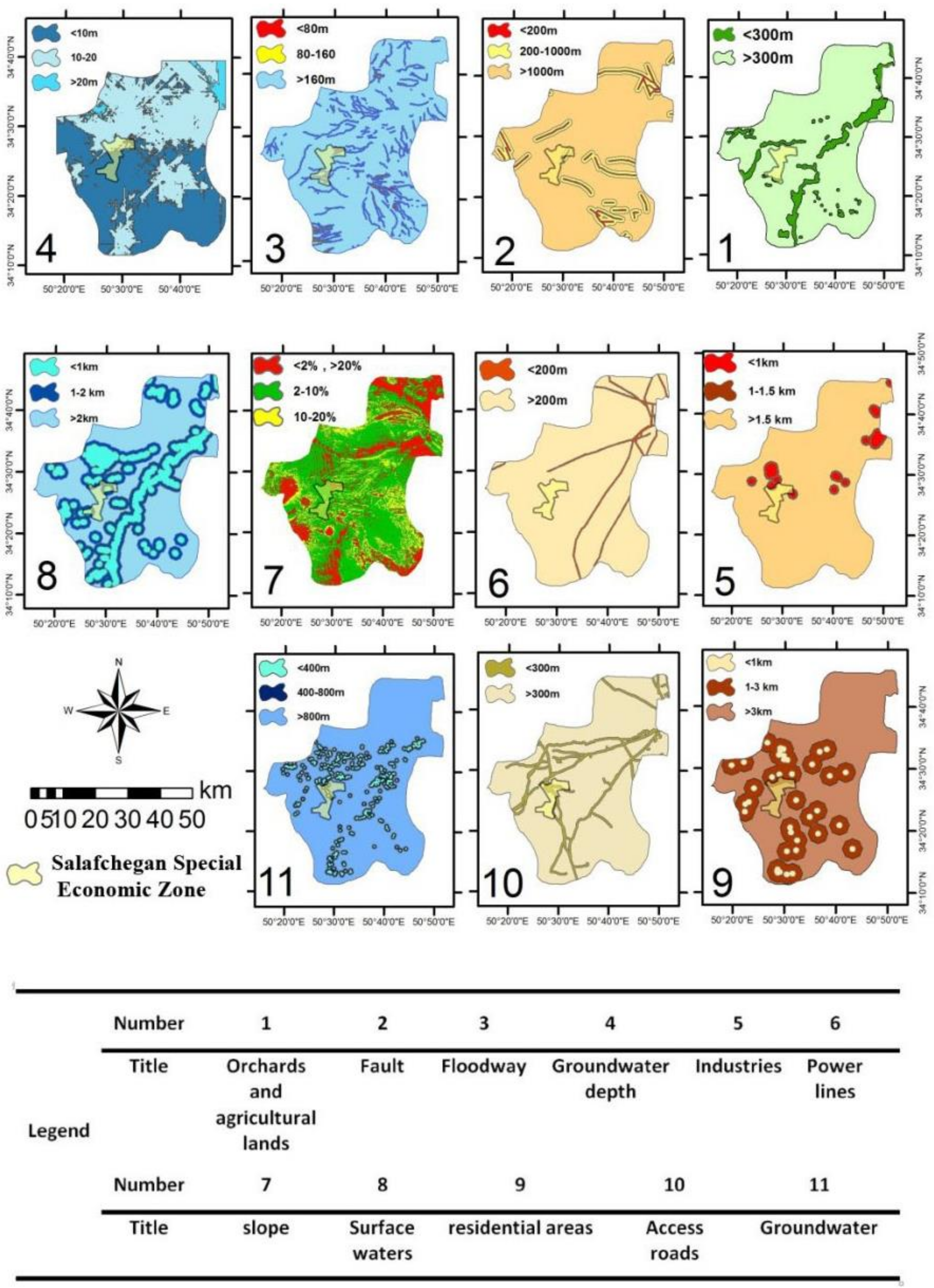
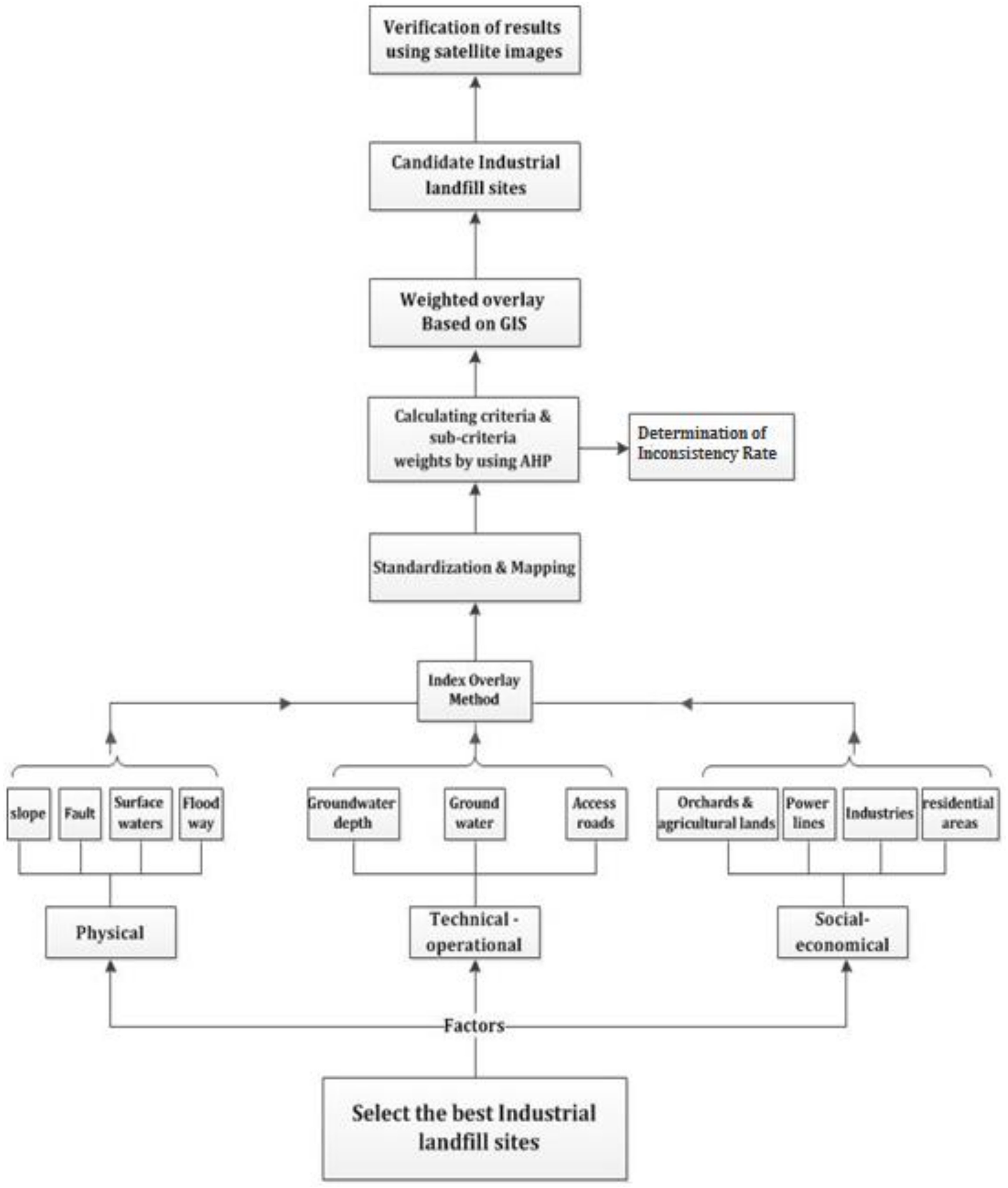
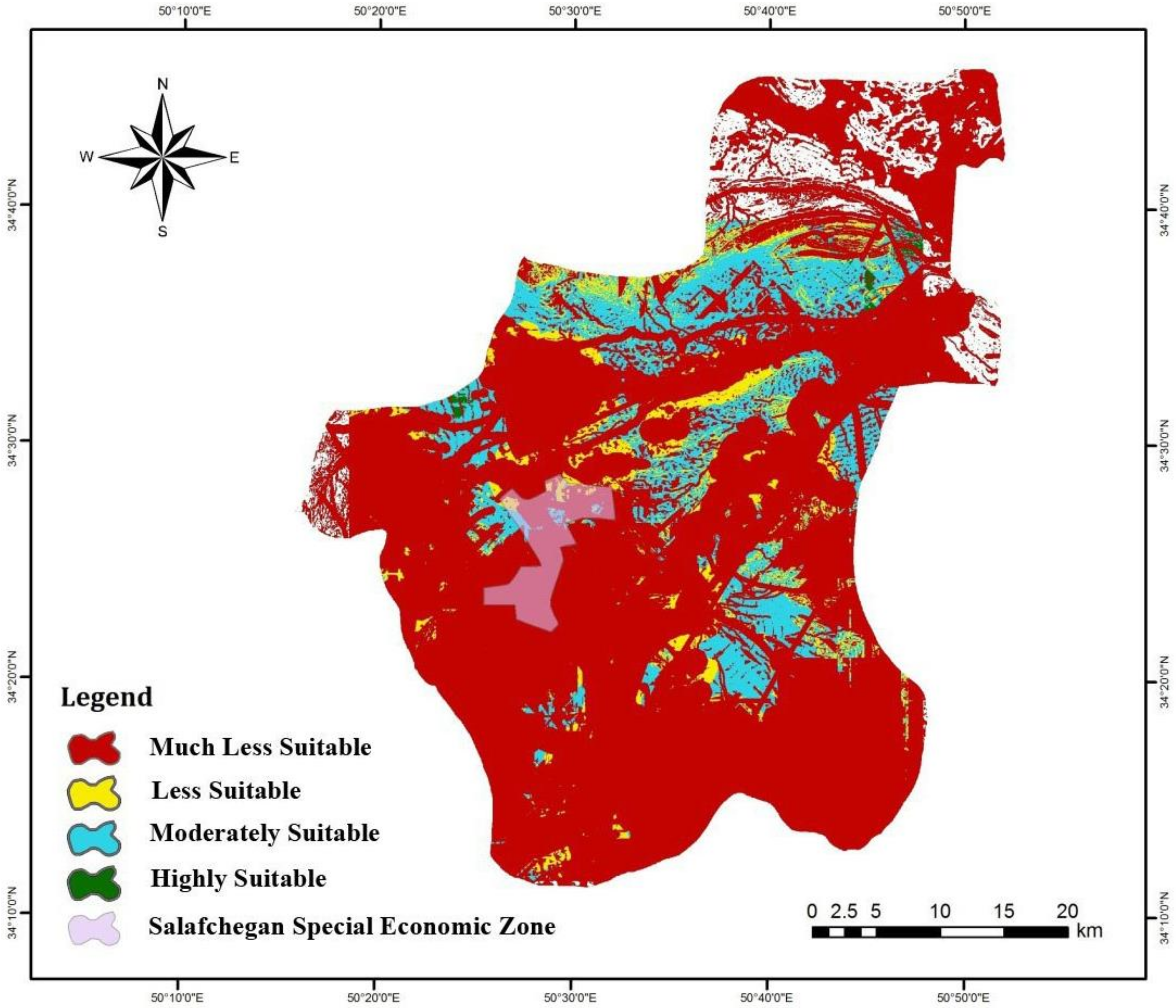
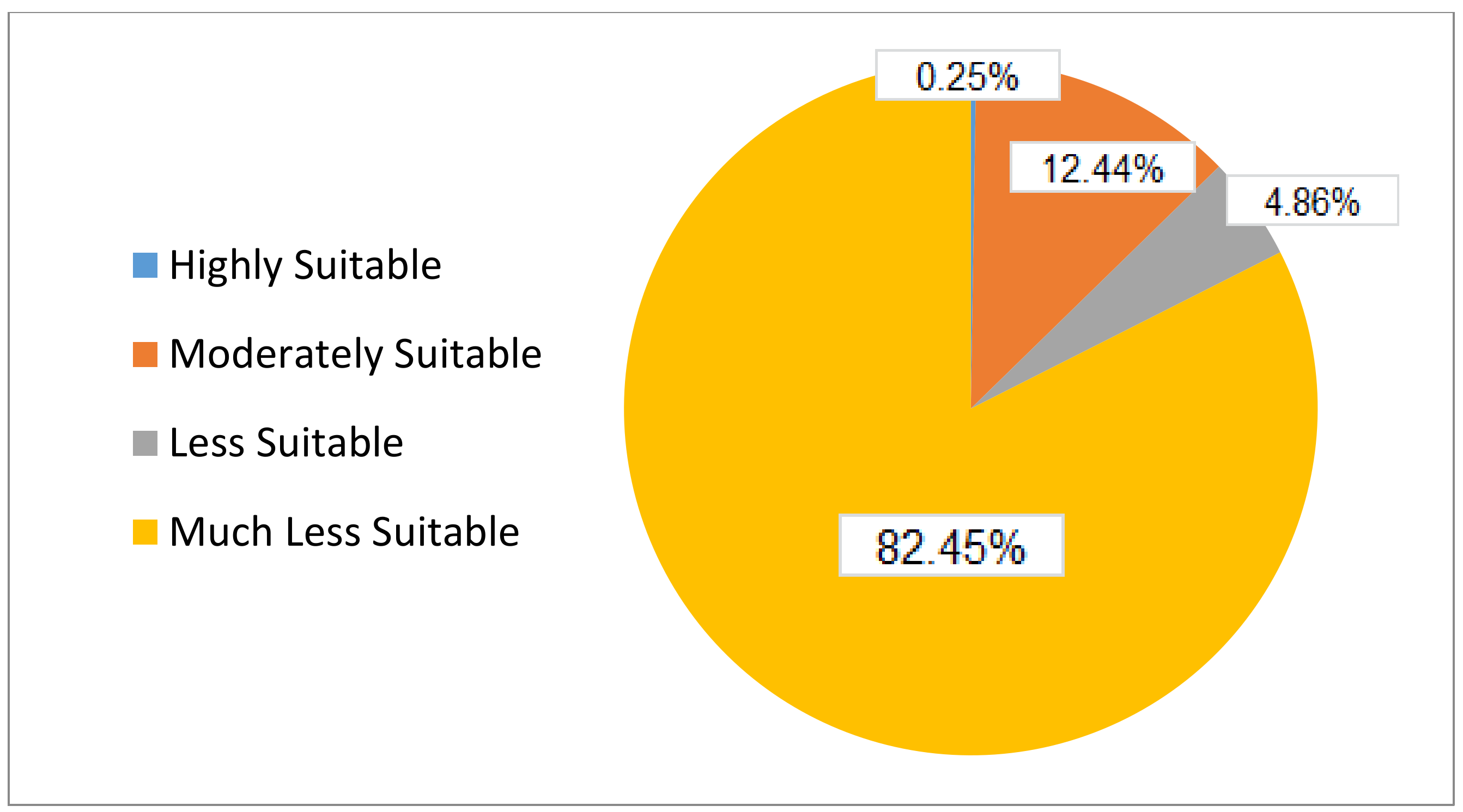
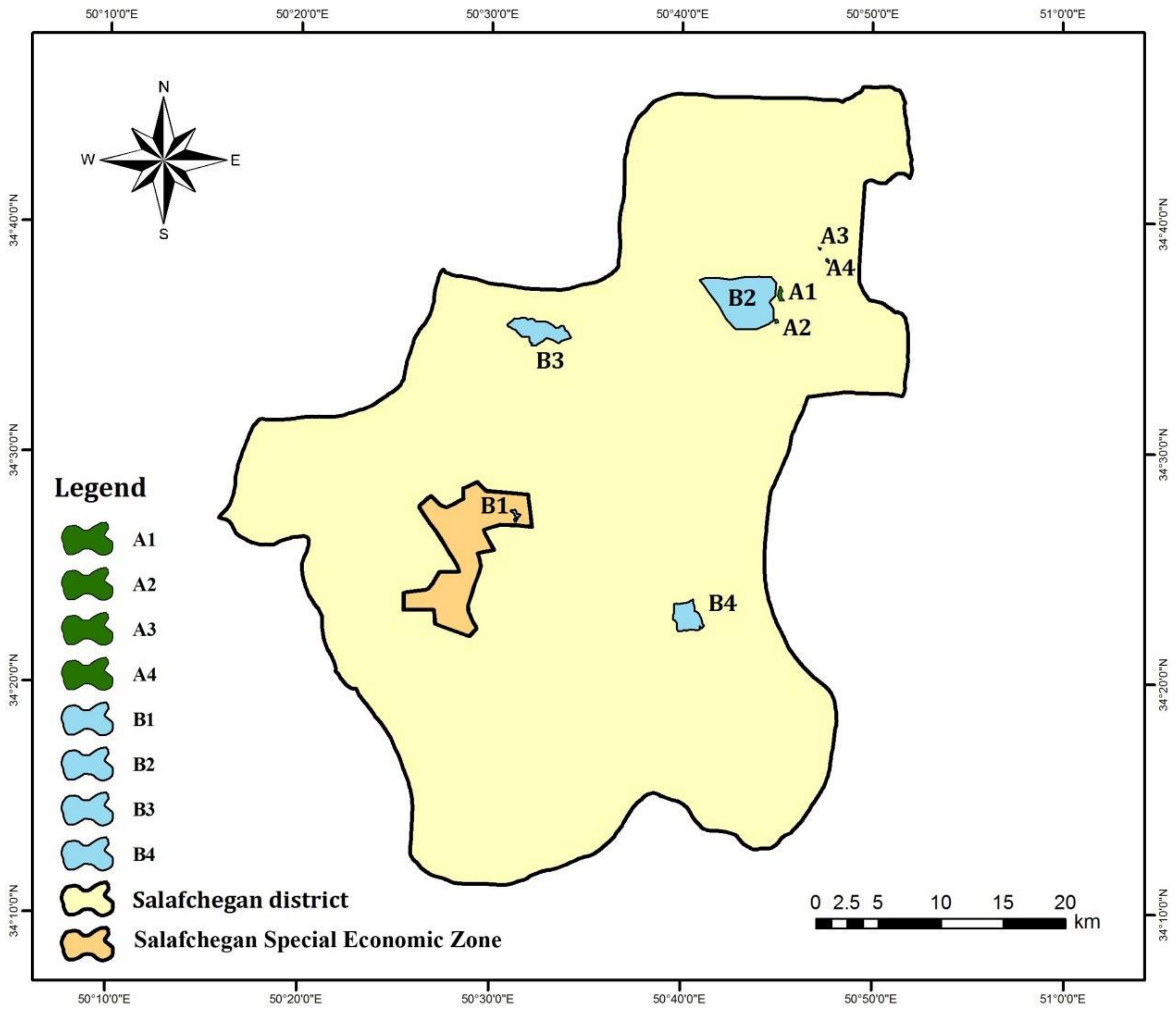
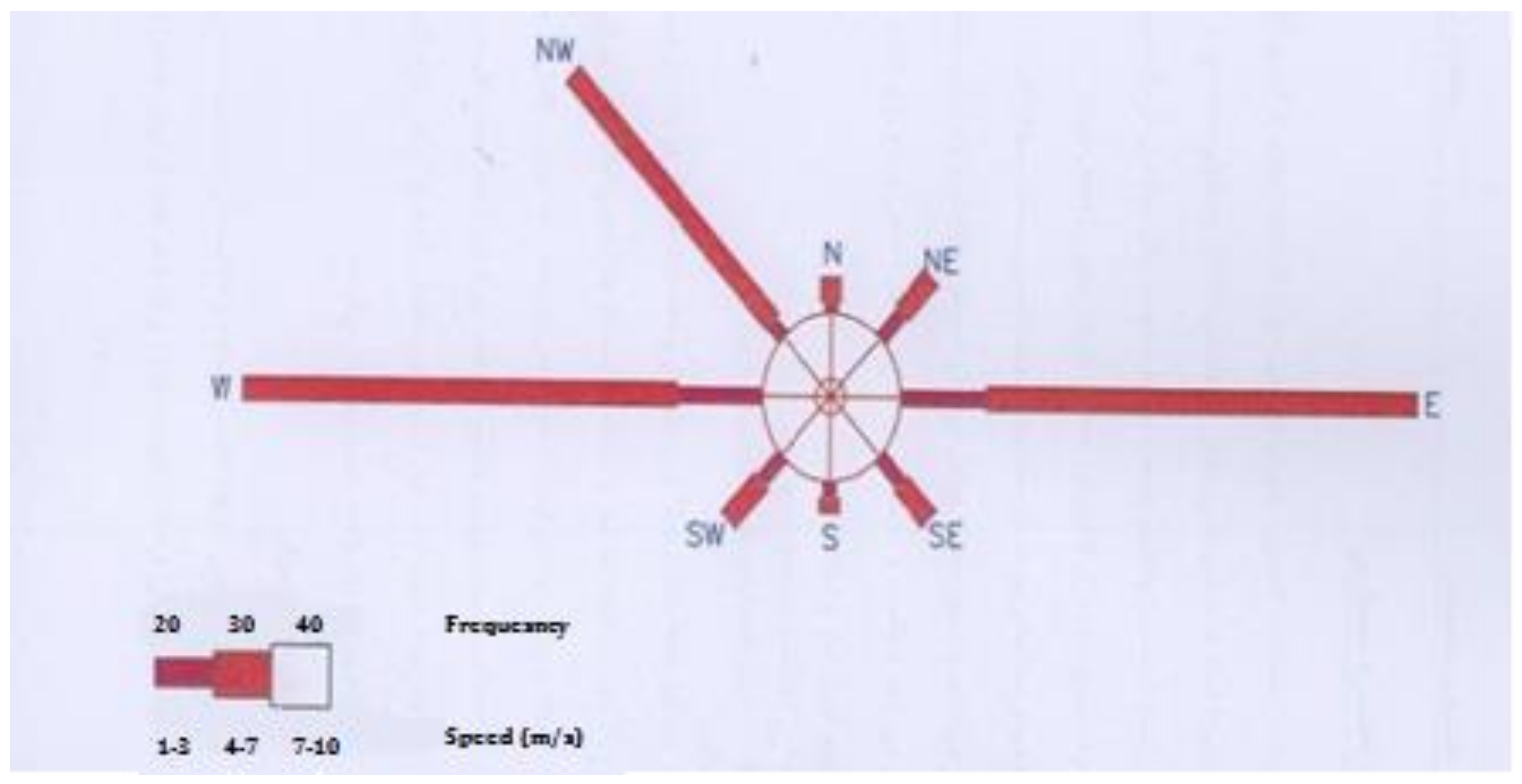
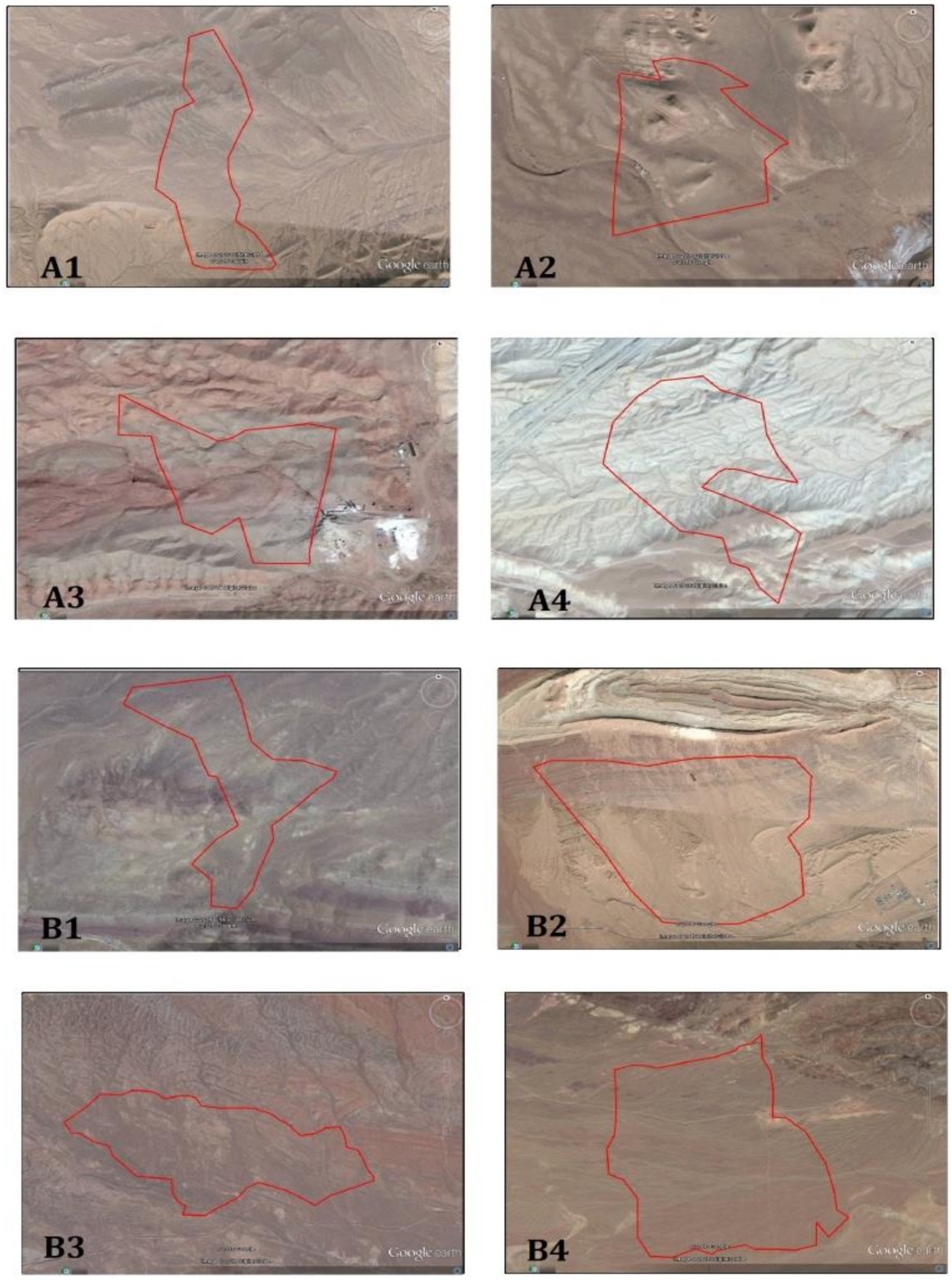
| Factors | Criteria | Sub-Criteria | Description | Reference |
|---|---|---|---|---|
| Physical | Floodway (m) | <80 | Less-suitable | [43] |
| 80–160 | Suitable | |||
| >160 | Highly-suitable | |||
| Surface waters (m) | <1000 | Less-suitable | [43] | |
| 1000–2000 | Suitable | |||
| >2000 | Highly-suitable | |||
| Fault (m) | <200 | Less-suitable | [43] | |
| 200–1000 | Suitable | |||
| >1000 | Highly-suitable | |||
| Slope (%) | <2, >20 | Less-suitable | [44] | |
| 2–10 | Highly-suitable | |||
| 10–20 | Suitable | |||
| Technical-operational | Groundwater depth (m) | <10 | Less-suitable | [44] |
| 10–20 | Suitable | |||
| >20 | Highly-suitable | |||
| Groundwater (m) | <400 | Less-suitable | [45] | |
| 400–800 | Suitable | |||
| >800 | Highly-suitable | |||
| Access roads (m) | <300 | Less-suitable | [45] | |
| >300 | Highly-suitable | |||
| Social-economical | Residential areas (m) | <1000 | Less-suitable | [43] |
| 1000–3000 | Suitable | |||
| >3000 | Highly-suitable | |||
| Industries (m) | <1000 | Less-suitable | [43] | |
| 1000–1500 | Suitable | |||
| >1500 | Highly-suitable | |||
| Power lines (m) | <200 | Less-suitable | [46] | |
| >200 | Highly-suitable | |||
| Orchards and agricultural lands (m) | <300 | Less-suitable | [43] | |
| >300 | Highly-suitable |
| Explanation | Definition | Intensity of Importance |
|---|---|---|
| Two factors contribute equally to the objective | Equal importance | 1 |
| Experience and judgment slightly favor one over the other | Somewhat more important | 3 |
| Experience and judgment strongly favor one over the other | Much more important | 5 |
| Experience and judgment very strongly favor one over the other. Its importance is demonstrated in practice. | Very much more important | 7 |
| The evidence favoring one over the other is of the highest possible validity. | Absolutely more important | 9 |
| When compromise is needed | Intermediate values | 2,4,6,8 |
| Criteria | Weights | Sub-Criteria | Sub-Weights |
|---|---|---|---|
| Floodway (m) | 0.03 | <80 | 0.109 |
| 80–160 | 0.309 | ||
| >160 | 0.582 | ||
| Surface waters (m) | 0.091 | <1000 | 0.109 |
| 1000–2000 | 0.309 | ||
| >2000 | 0.582 | ||
| Fault (m) | 0.051 | <200 | 0.109 |
| 200–1000 | 0.309 | ||
| >1000 | 0.582 | ||
| Slope (%) | 0.184 | <2, >20 | 0.109 |
| 2–10 | 0.582 | ||
| 10–20 | 0.309 | ||
| Groundwater depth (m) | 0.227 | <10 | 0.109 |
| 10–20 | 0.309 | ||
| >20 | 0.582 | ||
| Groundwater (m) | 0.053 | <400 | 0.109 |
| 400–800 | 0.309 | ||
| >800 | 0.582 | ||
| Access roads (m) | 0.072 | <300 | 0.1 |
| >300 | 0.9 | ||
| Residential areas (m) | 0.103 | <1000 | 0.109 |
| 1000–3000 | 0.309 | ||
| >3000 | 0.582 | ||
| Industries (m) | 0.024 | <1000 | 0.109 |
| 1000–1500 | 0.309 | ||
| >1500 | 0.582 | ||
| Power lines (m) | 0.015 | <200 | 0.1 |
| >200 | 0.9 | ||
| Orchards and agricultural lands (m) | 0.15 | <300 | 0.1 |
| >300 | 0.9 |
| Highly Suitable | Moderately Suitable | Less Suitable | Much Less Suitable | Selected Priorities |
| 4.77085 | 237.1891 | 92.54218 | 1571.45 | Area (km2) |
| Selected Areas | Area (ha) | Groundwater Depth (m) | Distance of Residential Areas (km) | Distance of Salafchegan Special Economic Zone | The Prevailing Wind Direction | Land Use |
|---|---|---|---|---|---|---|
| A1 | 35.2 | >20 | >3 | 26.7 | East–West | moderate rangeland–barren land |
| A2 | 7.9 | >20 | >3 | 24.9 | East–West | moderate rangeland |
| A3 | 3.5 | >20 | >3 | 31.4 | East–West | moderate rangeland |
| A4 | 6.8 | >20 | >3 | 31.1 | East–West | barren land |
| B1 | 26.2 | 10–20 | >3 | inside | East–West | moderate rangeland |
| B2 | 1849.3 | 10–20 | >3 | 22.6 | East–West | moderate rangeland–barren land |
| B3 | 632.7 | 10–20 | >3 | 12.7 | East–West | moderate rangeland |
| B4 | 428.6 | 10–20 | 1–3 | 14.1 | East–West | Poor rangeland |
© 2018 by the authors. Licensee MDPI, Basel, Switzerland. This article is an open access article distributed under the terms and conditions of the Creative Commons Attribution (CC BY) license (http://creativecommons.org/licenses/by/4.0/).
Share and Cite
Yousefi, H.; Javadzadeh, Z.; Noorollahi, Y.; Yousefi-Sahzabi, A. Landfill Site Selection Using a Multi-Criteria Decision-Making Method: A Case Study of the Salafcheghan Special Economic Zone, Iran. Sustainability 2018, 10, 1107. https://doi.org/10.3390/su10041107
Yousefi H, Javadzadeh Z, Noorollahi Y, Yousefi-Sahzabi A. Landfill Site Selection Using a Multi-Criteria Decision-Making Method: A Case Study of the Salafcheghan Special Economic Zone, Iran. Sustainability. 2018; 10(4):1107. https://doi.org/10.3390/su10041107
Chicago/Turabian StyleYousefi, Hossein, Zahra Javadzadeh, Younes Noorollahi, and Amin Yousefi-Sahzabi. 2018. "Landfill Site Selection Using a Multi-Criteria Decision-Making Method: A Case Study of the Salafcheghan Special Economic Zone, Iran" Sustainability 10, no. 4: 1107. https://doi.org/10.3390/su10041107
APA StyleYousefi, H., Javadzadeh, Z., Noorollahi, Y., & Yousefi-Sahzabi, A. (2018). Landfill Site Selection Using a Multi-Criteria Decision-Making Method: A Case Study of the Salafcheghan Special Economic Zone, Iran. Sustainability, 10(4), 1107. https://doi.org/10.3390/su10041107







